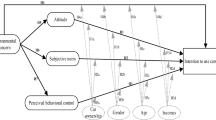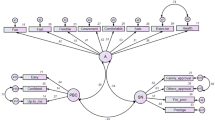Abstract
The most common daily trip for employed persons and students is the commute to and from work and/or place of study. Though there are clear environmental, health and safety benefits from using public transport instead of private vehicles for these trips, a high proportion of commuters still choose private vehicles to get to work or study. This study reports an investigation of psychological factors influencing students’ travel choices from the perspective of the Theory of Planned Behaviour (TPB). Students from three different university campuses (n = 186) completed a cross-sectional survey on their car commuting behaviour. Particular focus was given to whether car commuting habits could add to understanding of commuting behaviour over and above behavioural intentions. Results indicated that, as expected, behavioural intention to travel by car was the strongest TPB predictor of car commuting behaviour. Further, general car commuting habits explained additional variance over and above TPB constructs, though the contribution was modest. No relationship between habit and intentions was found. Overall results suggest that, although student car commuting behaviour is habitual in nature, it is predominantly guided by reasoned action. Implications of these findings are that in order to alter the use of private vehicles, the factors influencing commuters’ intentions to travel by car must be addressed. Specifically, interventions should target the perceived high levels of both the acceptability of commuting by car and the perceived control over travel undertaken by private vehicle.
Similar content being viewed by others
Notes
While the order in which the variables were entered into the hierarchical regression was theoretically determined, a second regression was conducted for exploratory purposes. In this exploratory regression, Habit and Intentions were entered simultaneously at step 1, followed by the Interaction at step 2. This model confirmed that Intentions was the stronger predictor, with a β of 0.575 as compared to Habit, which had a β of 0.248. Although both of these β were significant, Habit only accounted for 10% of the unique variance (sr2 = 0.1) compared to Intentions which accounted for 36% (sr2 = 0.36).
References
Aarts, H., Verplanken, B., Van Kippenberg, A.: Habit and information use in travel mode choice. Acta. Psychol. 96, 1–14 (1997)
Ajzen, I.: The theory of planned behavior. Organ. Behav. Hum. Decis. Process. 50, 179–211 (1991)
Armitage, C.J., Conner, M.: Efficacy of the theory of planned behaviour: a meta-analytic review. Br. J. Soc. Psychol. 40(4), 471–499 (2001)
Australian Bureau of Statistics.: Australian social trends 1996 transport—special features: car use. Retrieved April 25, 2004, from http://www.abs.gov.au/Ausstats/abs@nsf/0/73f5696b10a8f71dca2569d000164394?OpenDocument (1996)
Australian Government Department of Environment and Heritage.: Global warming: cool it! transport. Retrieved April 25, 2004, from http://www.greenhouse.gov.au/gwci/transport.html (2005)
Australian Transport Safety Bureau.: Retrieved April 25, 2004, from http://www.atsb.gov.au/index.cfm (2005)
Bamberg, S., Ajzen, I., Schmidt, P.: Choice of travel mode in the theory of planned behavior: the roles of past behavior, habit, and reasoned action. Basic Appl. Soc. Psychol. 25(3), 175–187 (2003a)
Bamberg, S., Rolle, D., Weber, C.: Does habitual car use not lead to more resistance to change of travel mode? Transportation 30(1), 97–108 (2003b)
Daily, J.M., Martin, J.H.: Situational analysis of bus riders and non-riders for different transportation methods. Logist. Transp. Rev. 24(2), 185–199 (1988)
Davidov, E., Schmidt, P., Bamberg, S.: Time and money an empirical explanation of behavior in the context of travel-mode choice with the german microcensus. Eur. Sociol. Rev. 19(3), 267–280 (2003)
Doyle, B.: Travel to and from work and place of study, Brisbane and Moreton statistical divisions. Retreived April 25, 2004, from http://www.ausstats.abs.gov.au/ausstats/subscriber.nsf/0/CA25687100069892CA2568890028AA92/$File/92013_Oct%201997.pdf (1998)
Elliott, M.A., Armitage, C.J., Baughan, C.J.: Drivers’ compliance with speed limits: an application of the theory of planned behaviour. J. Appl. Psychol. 88, 964–972 (2003)
Francis, J., Eccles, M., Johnston, M., Walker, A., Grimshaw, J., Foy, R., Kaner, E., Smith, L., Bonetti, D.: Constructing Questionnaire Based on the Theory of Planned Behaviour. Centre for Health Services Research, UK (2004)
Fujii, S., Kitamura, R.: What does a one-month free bus ticket do to habitual drivers? Transportation 30(1), 81–95 (2003)
Garvill, J., Marell, A., Nordlund, A.: Effects of increased awareness on choice of travel mode. Transportation 30(1), 63–79 (2003)
Greenslade, J.H., White, K.M.: The prediction of above regular participation in volunteerism: a test of theory of planned behaviour and the volunteers functions inventory. J. Soc. Psychol. 145(2), 155–172 (2005)
Hanna, J.B., Drea, J.T.: Understanding and predicting passenger rail travel: an empirical study. Transp. J. 38(1), 38–46 (1998)
Newnam, S.A., Watson, B.C., Murray, W.: Factors predicting intentions to speed in a work and personal vehicle. Transp. Res. Part F: Traffic Psychol. Behav. 7(4–5), 287–300 (2004)
Oullette, J.A., Wood, W.: Habit and intention in everyday life: the multiple processes by which past behavior predicts future behavior. Psychol. Bull. 124(1), 54–74 (1998)
Quit South Australia.: Tobacco in Australia. Available at: http://www.quitsa.org.au/cms_resources/documents/infosheet_tobacco_in_australia.pdf (2008)
Rhodes, R.E., Courneya, K.S.: Relationship between personality, an extended theory of planned behaviour model and exercise. J. Health Psychol. 1, 19–36 (2003)
Verplanken, B., Aarts, H., van Knippenberg, A.: Habit, information acquisition, and the process of making travel mode choices. Eur. J. Soc. Psychol. 27, 539–560 (1997)
Verplanken, B., Aarts, H., van Knippenberg, A., Moonen, A.: Habit versus planned behavior: a field experiment. Br. J. Soc. Psychol. 37, 111–128 (1998)
Author information
Authors and Affiliations
Corresponding author
Rights and permissions
About this article
Cite this article
Kerr, A., Lennon, A. & Watson, B. The call of the road: factors predicting students’ car travelling intentions and behaviour. Transportation 37, 1–13 (2010). https://doi.org/10.1007/s11116-009-9217-9
Published:
Issue Date:
DOI: https://doi.org/10.1007/s11116-009-9217-9




